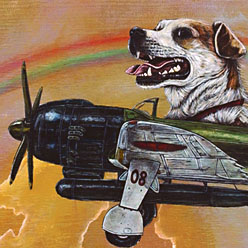If you’re like me, you took a road trip with your mom when you were in the seventh grade, driving from New Mexico to Illinois to visit your great-grandmother. You called her Mee-Maw. It was winter, and you and mom drove there and back in a 1982 Bonneville that had no cassette player. Instead, you used the boombox you had been given the previous Christmas, a neon-yellow number that represented the apex of mid-’80s, under $50 electronic design. And you’ll also remember that mom didn’t really like your music, which consisted of The Bangles, Genesis, and Huey Lewis and the News (it wouldn’t be until the eighth grade that you discovered new wave). So mom played her one cassette, over and over, for thousands of miles: The Moody Blues’ Days of Future Passed. It was the only time in your life when you got your mom to yourself for more than a few hours, and by the time you went back through the weird McDonald’s that’s in an overpass in Oklahoma, you had the whole album memorized.It’s understandable, then, that when you heard about the upcoming exhibit at South Broadway Cultural Center called Days of Future Past , you felt a tinge of nostalgia. … OK, I did; I felt it. And it turns out, it’s not just me.The show features four artists: Joshua Franco, Brandon Maldonado, Chris Perez and Santiago Perez, who collectively are known as Los Fantasticos because, as Santiago Perez says, "We do fantastical painting." The collective came together when Perez asked the other three artists to do a show with him. Perez has been painting for decades, but the rest are younger, and he was excited by their work. "I do a lot of fairy tales and legends, literary, hymns, songs that I base my imagery on. I felt that these three other painters as well had extraordinary realism or surrealism going on in their work."The imagination and free association that are hallmarks of surrealism can be found throughout the work of Los Fantasticos. Josh Franco’s pieces draw from graphic art and are, as Perez describes them, "infused with humor in the typical surrealist jumble of images," such as an oversized dog flying a propellered fighter plane. Brandon Maldonado creates images that have a contemporary edge, with large-headed children in sometimes frightening circumstances. They are inspired by anime and tattoos, depicting, according to Perez, "a child that looks innocent but already knows about the tragic aspects of the world."The work of Chris Perez (no relation) is the most realistic of the bunch, drawing upon the traditions of Spanish painters of the Golden Age. But the juxtapositions in his work are modern, as displayed by masked Chicano men in sweatshirts brandishing swords on either side of a traditionally dressed woman. These anachronisms are part of the play that suffuses the show.The connection to The Moody Blues album comes in the group’s desire to "go back to the past and get imagery and bring it to the future," Santiago Perez says. His work embodies this mission. It is darkly whimsical, bringing together recognizable figures such as the Arthurian Green Knight alongside creatures of his own design, including large-beaked crows that wear outfits, replete with hats that indicate their occupations. It’s as if Richard Scarry and Maurice Sendak and at least one Brother Grimm had a biologically improbable love child.The show found its home at the South Broadway Cultural Center when Perez met Augustine Romero, curator for the SBCC and KiMo Theatre. Romero says the show is different than many group shows. "A lot of curators come from a theoretical place, but when artists come as a group, you get a sense of direction." So rather than see what a curator has interpreted as commonalities, an audience gets an understanding of how the artists see their own work.And how do they see that work? Perhaps it’s that the "real" world is just a fragment of our experience and that the fantasies we dream and the stories we tell are a vital part of our lives. There’s a healthy heap of nostalgia in the show, but not for a world that once existed and no longer does. Rather, it’s a nostalgia for a way of seeing things, the world as a string of silly possibilities, unbound be logic. Or, as The Moody Blues tells it, "Just what the truth is / I can’t say anymore … Just what you want to be / You will be in the end." But you knew that.
Days of Future Past runs at the South Broadway Cultural Center (1025 Broadway SE) from June 2 to July 27. The opening reception will be held on Thursday, June 4, from 6 to 9 p.m. and will feature music composed for the event, as well as some tunes from Days of Future Passed. For more, go to cabq.gov/sbcc.















